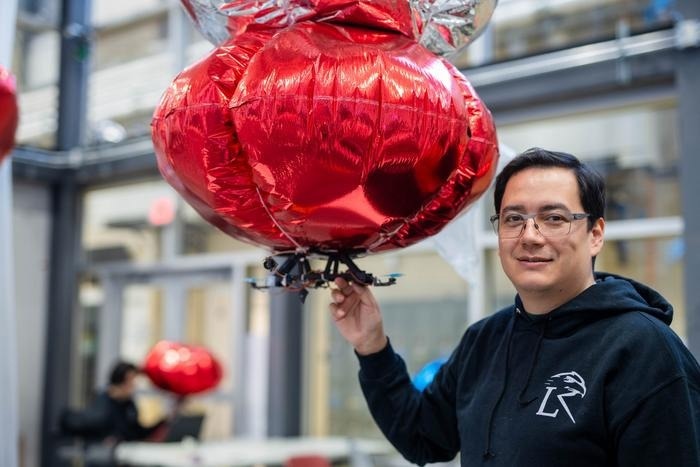With an NSF CAREER award and inspiration from nature, Lehigh University researcher David Saldaña hopes to improve the capabilities of aerial robots, enabling them to manipulate flexible materials and adjust to changing stresses in real-time.
 David Saldaña is an assistant professor in the Department of Computer Science and Engineering at Lehigh University. He leads the SwarmsLab and contributes to the Autonomous and Intelligent Robotics (AIR) Lab. His research focuses on multi-robot systems, swarm robotics, and aerial manipulation, with applications in environmental monitoring, disaster response, and construction. Saldaña’s work aims to develop resilient, adaptive robotic systems capable of operating in dynamic and unpredictable environments. Image Credit: Christa Neu/Lehigh University
David Saldaña is an assistant professor in the Department of Computer Science and Engineering at Lehigh University. He leads the SwarmsLab and contributes to the Autonomous and Intelligent Robotics (AIR) Lab. His research focuses on multi-robot systems, swarm robotics, and aerial manipulation, with applications in environmental monitoring, disaster response, and construction. Saldaña’s work aims to develop resilient, adaptive robotic systems capable of operating in dynamic and unpredictable environments. Image Credit: Christa Neu/Lehigh University
Inspiration can strike at any time, any place, and from almost anything.
I was walking my dog and watching a squirrel jump from tree branch to tree branch. I started thinking about how quickly the animal has to adapt to the different properties of each branch and to the forces generated by their movement. And that is when the idea hit me how could we get robots, especially aerial robots, to adapt like that?
David Saldaña, Assistant Professor, Computer Science and Engineering, Lehigh University
Saldaña, who directs the SwarmsLab, has secured nearly $600,000 in funding from the National Science Foundation’s Faculty Early Career Development (CAREER) Program to answer this topic. His research will look into ways to improve aerial robots' ability to manipulate and move flexible things, including wires, rods, hoses, and plastic sheets. Construction, emergency response, and industrial automation are all potential applications.
The prestigious NSF CAREER award is granted yearly to junior faculty members in the United States who exemplify the role of teacher-scholars by conducting exceptional research, providing excellent instruction, and integrating education and research. Each award provides consistent support over five years.
Aerial robots can only manipulate rigid objects such as boxes because the dynamic and unpredictable pressures associated with flexible materials pose distinct obstacles.
For example, if you want to grab an apple from a tree branch, the branch will generate a force against you. As humans, we are naturally able to respond to those forces, but it is still a big problem for robots. We want them to learn how to adapt to and compensate for them.
David Saldaña, Assistant Professor, Computer Science and Engineering, Lehigh University
To do that, Saldaña and his group are creating a new approach that combines reinforcement learning and control systems to guarantee time-critical recovery, enable rapid learning, and preserve stability.
Saldaña added, “This integration and the ability to learn quickly means that the robot would not need to do something thousands of times before it can move one of these flexible objects. And the more pieces it moves, the more efficient it becomes.”
The project starts with creating an adaptive controller that assures stability and enables real-time adjustment for external pressures without prior knowledge of an object's material qualities.
The controller provides a foundation for reinforcement learning, allowing aerial robots to explore and optimize control techniques through interaction. The framework, which includes adaptive control and reinforcement learning, blends the reliability of baseline stability with the agility and efficiency of learned techniques.
“This type of integration has never been done before,” added Saldaña.
According to him, the construction industry, particularly skyscrapers and other high-rise buildings, is the most promising field for application. Drones might deliver and place cables and rods traditionally handled by people, lowering costs while increasing worker safety. Other uses include installing plastic sheeting over rooftops during hurricanes and manipulating emergency fire hoses.
However, before drones can assist humans, their developers must overcome the obstacles of real-time adaptation in a world of continual actions and reactions—a world in which many organisms act instinctively.
“I am excited to solve new problems and see what squirrel capabilities we can give to aerial robots,” concluded Saldaña.